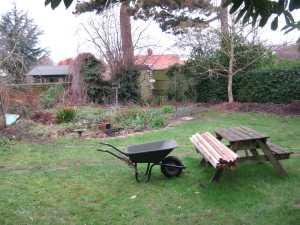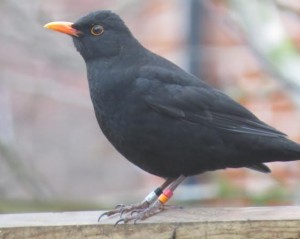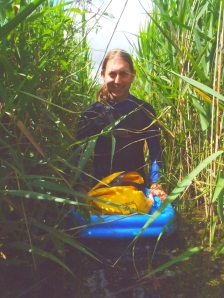1. Why gardens?

The ringing site is a typical suburban garden. One of the traps can be seen in the corner, above the wheelbarrow. Photo: Dave Leech
My name is Dave Leech and I’m a ringer and a nest recorder for the British Trust for Ornithology (BTO), where I also work. The Holt Blackbird Project is a ringing study that I set up in 2007, soon after qualifying as a BTO bird ringer. My goal while training was to use my new-found skills to answer specific questions about the avifauna around me and make a real contribution to conservation. The ecology of birds in gardens has always been a particular interest of mine – why do some species do so well, do suburban and urban birds fare better than those breeding in woods and scrub? Sadly, I lack a yard of any kind at my own house in Thetford, so I commandeered my parents’ garden in Holt instead! I’m not quite sure they realised what they were getting into, but I’m still welcome eight years down the line (I think my Mum twigged that it was a good way of ensuring I made regular visits to the family home).
Holt provided the perfect location for a study on garden birds. This small market town situated close to the North Norfolk coast (a fact not entirely unrelated to my interest in all things ornithological) is where I grew up and my parents have lived there for 35 years. The town has a very tight-knit community and its proximity to the Norfolk Wildlife Trust reserve at Cley ensures that many residents are keen birders. It’s an extremely friendly place and I knew that folk would both be extremely interested in the project and very helpful when it came to collecting data.
2. Why Blackbirds?
Blackbirds are a very charismatic species that have colonised gardens very successfully; analysis of BTO/RSPB/JNCC Breeding Bird Survey (BBS) data by my colleague Stuart Newson estimated that around 30% of the UK’s Blackbird population now breeds around human habitation. Numbers declined significantly between the mid 1970s and mid 1990s, but the population has made a partial recovery subsequently, although BBS data suggest that numbers in London are still falling. From a logistical perspective, they’re also a great bird to work with as a ringer as they’re present in high densities and relatively easy to catch.
3. Why ringing?

The Holt Blackbird Project is registered as a RAS – find out more about the RAS scheme on the BTO website at http://www.bto.org/ras
The main use of bird ringing in the 21st Century is not, as many think, to track movements of migrant birds but rather to monitor survival rates. Traditionally, this was achieved via recoveries of dead birds reported to BTO by the public, which works well for large, obvious birds that are likely to be found post-mortem (e.g. Barn Owl), but is less effective for smaller songbirds or species inhabiting remote areas. Increased computerisation and development of new statistical techniques now enables much of the survival information for these species to be generated from birds recaptured by ringers, essentially asking ‘what proportion of birds marked last year are still alive’ rather than ‘what proportion are known to have died’. The best quality information is obtained if the catching effort is standardised each year, and BTO currently operates two focused ringing projects, the Constant Effort Scheme and the Retrapping Adults for Survival (RAS) scheme; the Holt Blackbird Project is registered for RAS.
The data generated are used alongside information on breeding success collected by volunteers taking part in the BTO Nest Record Scheme to help us understand why bird numbers are changing; are declines caused by fewer young being produced or are fewer adults surviving over the winter? This is the essential first step in addressing the problem.

Male Red over Orange, Black over Metal (RONM) has taken up residence 500m from the ringing site. Photo: Maggie Wilcox
4. Why colour-ringing?
The use of metal rings is sufficient if a ringer is regularly operating at a site but colour rings open the project up to a much wider audience. For practical purposes, living over a hour away, help from others was always going to be key to the success of the study. I was particularly keen to get non-ringers, and even non-birders, involved in the Holt Blackbird Project as I was convinced that the insight into the birds’ lives it provides would be of interest while also raising awareness of both ringing and urban bird conservation. The response has been amazing, with a small army of Holt Blackbird Observers (HoBOs) already recruited, and as a result we’ve been able to collect data not just on survival rates but also on the movement of individual birds around the town.
5. About me
I grew up in Holt, having moved there when I was three. My Dad, Tony, was a biology teacher at Gresham’s School and both he and my Mum, Barbara, got me interested in natural history at a very early age. They weren’t particularly birdy, but a succession of fantastic teachers (Peter Smith, Ralph Wiggins and Dave Horsley) got me completely hooked and by the time I went to study at Oxford for a Biological Sciences degree, I had a pretty clear idea of what I wanted to do. A PhD on Blue Tit breeding behaviour at Lancaster University with Dr Ian Hartley followed, and it was here I started training to ring.

When looking for Reed Warbler nests in the reeds, a wetsuit and an inflatable baby bath are essentials. Photo: Rachel Barber
From Lancaster I moved to the British Trust for Ornithology (BTO) in Thetford, where I’ve been for the last 12 years. My job at BTO involves overseeing the Nest Record Scheme and the CES and RAS ringing projects, making sure that we continue to collect high quality demographic data through our network of amazing volunteer nest recorders and ringers. The job is pretty much desk-based, so I take every opportunity I can out of hours to get out into the field. Nest finding is a particular passion and I monitor around 500 breeding attempts a year, many of them as part of a study on Reed Warblers near Mundford that started as a hobby project and has grown out of all proportion (hence my reliance on the HoBOs for Blackbird resightings)!
